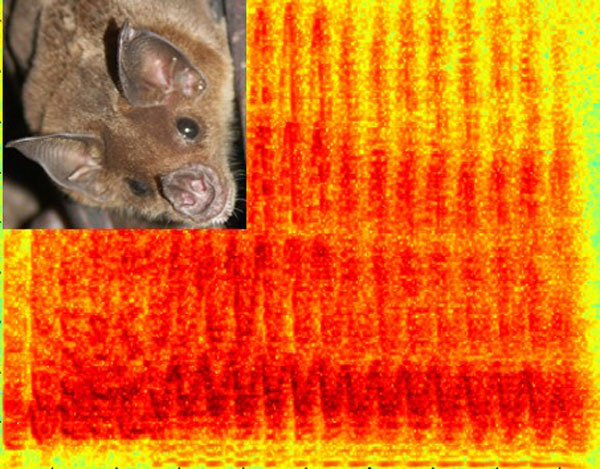Temporal modulations of sound amplitude and frequency are important features of human speech and animal communication sounds. Manipulation of these features impairs comprehensibility of speech in humans. Neuronal processing of temporal modulations is therefore crucial to vocal communication and the specific modulation patterns of different sounds have to be thoroughly reproduced during vocal learning. In communication calls of the bat P. discolor temporal modulations in the range of 130 Hz are prominent. However, cortical processing of temporal modulations is typically thought to be limited to lower frequencies, raising the question if and how the fast temporal modulations of behaviorally relevant communication sounds are represented in the auditory cortex of this bat species.

Figure: Phyllostomus discolor, and a spectrogram of a species-specific call
We investigated the coding of temporally modulated sounds in neurons in the auditory cortex of the bat P. discolor: we recorded the neuronal activity in anesthetized bats to playbacks of artificial sounds (sinusoidally amplitude modulated pure tones) varying in modulation frequency (the “tempo” of modulation) and communication calls. Surprisingly, cortical neurons in a spatially confined area, the posterior dorsal part of the auditory cortex, showed strong and temporally precise responses to unusually high modulation frequencies around 130 Hz. These neurons could also precisely encode the temporal fine structure of species-specific communication calls.
Our findings show that neural processing in the posterior dorsal auditory cortex of the bats seems to be well adapted to the high temporal sound modulations occurring in the vocal repertoire. This cortical area might therefore play an important role in species-specific communication. Within in the framework of our HFSP project ‘’The first mammalian model for vocal learning: a molecular, neural and comparative approach in bats” the results provide useful links to the work of the other co-investigators. The area in the dorsal cortex described here allows to further analyze neuronal processing of spectro-temporal features of communication calls. Tracing studies will establish connections to cortical sensory-motor areas and help to resolve the role of this specific area in vocal communication. Finally, our results open up the opportunity to test the role of language related genes such as FoxP2 in the processing of vocal communication sounds and vocal learning by selectively knocking down these genes in this area.


































